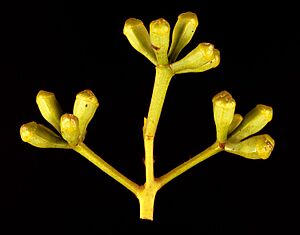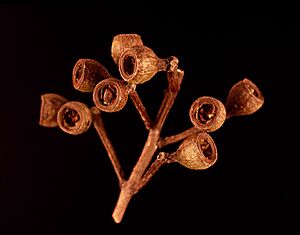Yellow tingle facts for kids
Quick facts for kids Yellow tingle |
|
|---|---|
 |
|
| Scientific classification | |
| Genus: |
Eucalyptus
|
| Species: |
guilfoylei
|
The Yellow Tingle (Eucalyptus guilfoylei) is a very tall tree that grows only in Western Australia. It's also known as Dingul Dingul. This amazing tree has a straight trunk with rough, grey-brown bark. Its leaves are shaped like a spear, and its flowers are white. After flowering, it grows fruit that look like small barrels.

Contents
What the Yellow Tingle Looks Like
The Yellow Tingle tree can grow very tall, usually between 5 and 40 meters (about 16 to 130 feet) high. Its trunk can be about 1 meter (3 feet) wide. It has rough, crumbly bark that is greyish-brown.
Leaves and Flowers
Young Yellow Tingle trees have egg-shaped leaves that are dark green on top. These leaves are about 80-130 mm (3-5 inches) long. Older trees have lance-shaped (spear-shaped) leaves. These adult leaves are dull green and about 80-150 mm (3-6 inches) long.
The tree's flower buds grow in groups of seven. They are shaped like a narrow egg. The Yellow Tingle flowers are white and bloom between November and January.
Fruit and Seeds
After the flowers, the tree grows woody fruit. These fruit are shaped like a globe, a pear, or a barrel. They are about 7-10 mm (0.3-0.4 inches) long. Inside the fruit are flat, saucer-shaped, reddish-brown seeds.
How Yellow Tingle is Different
The Yellow Tingle is related to other tingle trees, like the Red Tingle (Eucalyptus jacksonii). However, the Yellow Tingle's trunk is not widened at the base like some other tingles. Its bark stays on the tree, and its wood is yellow. All tingle trees can live for a very long time, sometimes up to 400 years!
Where the Yellow Tingle Lives
The Yellow Tingle tree is found in the coastal areas of the Great Southern region of Western Australia. It grows on slopes and ridges in hilly areas. You can find it between the Deep River and Frankland River, west of Albany.
Its Favorite Growing Spots
This tree grows best in deep red soils that come from basalt and dolerite rocks. It can also grow in lighter soils from granite and schists. The Yellow Tingle often grows among other large trees. These include the Karri (Eucalyptus diversicolor) and the Red Tingle (Eucalyptus jacksonii).
The Yellow Tingle looks a bit like the Jarrah tree. But the Yellow Tingle has less rough bark and lighter brown wood.
Why the Yellow Tingle is Useful
The wood from the Yellow Tingle's center is very hard. It has a straight grain and a yellow color, similar to oak wood. This strong wood is used for different purposes.



